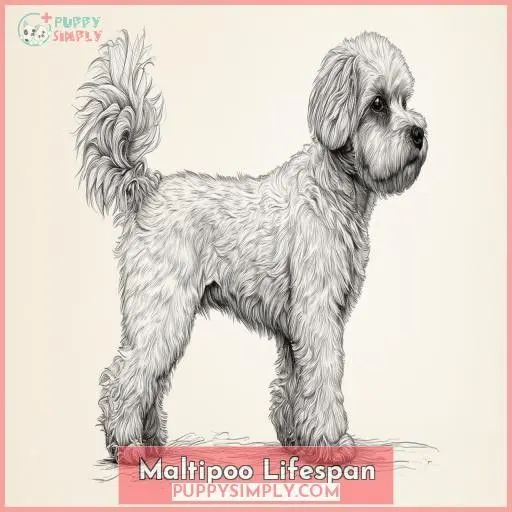This site is supported by our readers. We may earn a commission, at no cost to you, if you purchase through links.
 You’re in for an absolute delight with a Maltipoo, as these charming pups can live for 12 to 15 years on average.
You’re in for an absolute delight with a Maltipoo, as these charming pups can live for 12 to 15 years on average.
Their compact size and low-shedding coats contribute to their longevity.
However, providing proper care is essential to maximize their lifespan.
Make sure they have a nutritious diet, regular exercise, and vet check-ups to keep them in tip-top shape.
With their friendly, affectionate nature, Maltipoos make wonderful companions for over a decade.
Want to learn the secrets to helping your Maltipoo thrive?
Explore an in-depth exploration of factors affecting their lifespan.
Table Of Contents
- Key Takeaways
- How Long Do Maltipoos Live?
- Maltipoo Lifespan
- Factors Affecting Longevity
- Breed Characteristics
- Common Health Issues
- Caring for Senior Maltipoos
- Maximizing Maltipoo Lifespan
- Frequently Asked Questions (FAQs)
- Can a Maltipoo live 20 years?
- What is the leading cause of death for Maltipoos?
- Do Maltipoo have health problems?
- What are the symptoms of the end of life of a Maltipoo?
- Are Maltipoos good apartment dogs?
- How much do Maltipoos shed?
- Can Maltipoos be left alone?
- Are Maltipoos good with kids?
- How much do Maltipoos cost?
- Conclusion
Key Takeaways
- Maltipoos are little bundles of joy that can live up to 15 years on average, but don’t let their small size fool you – they require just as much love and care as any larger pup. Think of them as tiny, furry toddlers that will be a part of your family for well over a decade!
- These cuties are like the hot fudge sundae of the dog world – a delightful mix of the Maltese and Poodle breeds, inheriting the best of both worlds. Their hypoallergenic coats and friendly natures make them the perfect fit for many households.
- While their adorable antics and irresistible faces might be enough to make your heart melt, it’s essential to stay on top of their health needs. Routine vet visits, a balanced diet, and plenty of exercise (both mental and physical) are the keys to unlocking their full lifespan potential.
- As your Maltipoo enters their golden years, it’s like they’ve switched from a lively jig to a mellow waltz – adapt their routine accordingly. A little extra TLC, a cozy napping spot, and some senior-friendly tweaks will help them age gracefully by your side.
How Long Do Maltipoos Live?
How long do Maltipoos live? Maltipoos, a cross between the Maltese and Poodle breeds, typically have a lifespan of 10 to 15 years with proper care and a healthy lifestyle.
Maltipoo Lifespan
You’re probably wondering, "How long do Maltipoos live?"
Well, these cute pups typically have a lifespan of 12-15 years. Their small size and low-shedding coat contribute to their longevity, as smaller dogs tend to outlive larger breeds.
However, like any pet, proper care is essential for maximizing a Maltipoo’s lifespan. Maintaining their health through exercise, a nutritious diet, and regular vet check-ups can help guarantee your furry friend enjoys a long, happy life by your side.
With their friendly, affectionate nature, Maltipoos make wonderful companions for over a decade.
Factors Affecting Longevity
The lifespan of a Maltipoo is influenced by several key factors, including genetics inherited from its parent breeds, the quality of its diet and nutrition, the amount of exercise it receives, and the level of veterinary care provided throughout its life.
Hence, to maximize the longevity of your Maltipoo, it’s essential to understand and address these elements through responsible pet ownership practices.
Genetics
You can’t control your Maltipoo’s genes, but you should understand how they impact longevity. The breed’s origin and genetic variation influence lifespan potential. Inbreeding risks exist, so responsible breeders screen for health issues. Genetic testing helps predict problems like hip dysplasia. With proactive care, good nutrition, and senior accommodations, you’ll maximize your pup’s lifespan.
Diet and Nutrition
You can maximize your Maltipoo’s lifespan through proper diet and nutrition. Feed a high-quality, balanced diet designed for their life stage. Monitor for food allergies and avoid toxic human foods like chocolate and onions. Provide nutritious treats in moderation. Ensure adequate water intake, and consult your vet about dietary supplements if needed.
Exercise
You’ll want to provide your Maltipoo with plenty of exercise through regular walks and indoor play. Their lively nature requires daily activity to stay fit and happy. Opt for moderate exercise suited to their small size, like short walks mixed with indoor games. Keeping your pup active boosts their longevity and well-being.
Veterinary Care
You must stay diligent with your Maltipoo’s vet care. Follow their recommended vaccination schedule, and keep up with parasite prevention and dental hygiene. Be prepared for emergencies with complete pet insurance. Regular check-ups allow early detection of issues common to the breed, like allergies and orthopedic problems, helping maximize their lifespan.
Breed Characteristics
The Maltipoo breed originates from the intentional cross between the Maltese and Poodle, resulting in a compact, curly or wavy-coated companion dog that exhibits a friendly, affectionate, and playful temperament. With their adorable appearance and [WORDS TO FIND AND REPLACE]willing [/WORDS TO FIND AND REPLACE] nature, Maltipoos make delightful companions for many households.
Origin
You’re getting acquainted with the Maltipoo’s origins – its DNA traces back to intentionally crossbreeding the Maltese and Poodle breeds. This designer dog blends the best of both worlds: the Maltese’s sweet disposition with the Poodle’s intelligence and hypoallergenic coat. Hybrid vigor promises enhanced health in this popular crossbreed.
Appearance
You’ll be charmed by the Maltipoo’s adorable appearance – a compact build, round eyes, and a soft, curly coat in various shades like white, cream, or apricot. Their coat doesn’t shed much, making them an excellent choice for allergy sufferers. While their size varies based on the Poodle parent breed, their undeniable cuteness has skyrocketed this hybrid’s popularity.
Temperament
You’ll love the Maltipoo’s friendly, affectionate temperament. They’re:
- Playful and energetic, enthusiastic to join in family fun
- Adaptable to apartment living or houses with yards
- Trainable thanks to their intelligence and desire to please
- Devoted companions who bond tightly with their owners
- Sociable with guests, though grooming keeps shedding minimal
Their gentle nature and love for play make Maltipoos a delightful companion breed.
Common Health Issues
As a Maltipoo owner, it’s essential to be aware of the breed’s potential health issues.
These include dental problems like tooth decay and gum disease due to their small jaws. Allergies stemming from their mixed heritage are also common.
Orthopedic conditions such as patellar luxation or knee dislocation may occur. Eye problems, including infections and tear staining, are also prevalent in Maltipoos.
Regular grooming and veterinary check-ups are critical for maintaining their overall well-being.
Dental Problems
Dental hygiene is essential for your Maltipoo’s health. These pups are prone to tooth decay, gum disease, and canine caries. Stay ahead of dental woes with regular brushing, dental treats, and professional cleanings. Don’t neglect those pearly whites – dental X-rays and tooth extractions may become necessary if issues persist. An ounce of prevention equals a mouthful of healthy chompers!
Allergies
Along with dental issues, you’ll want to keep an eye out for allergies. Maltipoos can develop skin conditions, itchy paws, and other sensitivities from environmental triggers or their diet. Be mindful of potential allergens and discuss any concerns with your vet, who may recommend:
- Allergy testing
- Dietary changes
- Medication
- Frequent bathing
- Air purifiers
Addressing allergies promptly can improve your pup’s quality of life.
Orthopedic Conditions
You’ll want to watch for orthopedic issues like patellar luxation, where kneecaps slip out of place causing joint pain. Hip dysplasia and leg weakness from improper bone growth may also occur. With proper care, surgery recovery rates are high, but prevention through controlled exercise and a nutritious diet minimizes risks.
Eye Problems
Maltipoos can also experience eye problems – an area you’ll want to monitor closely. Common issues include:
- Tear stains (reddish-brown discoloration under the eyes)
- Eye infections (conjunctivitis, dry eye)
- Vision problems (cataracts, progressive retinal atrophy)
Proper grooming, cleaning routines, and regular vet check-ups can help prevent or manage many of these eye-related concerns.
Caring for Senior Maltipoos
As your Maltipoo enters its senior years, you’ll notice physical changes like graying fur, reduced muscle tone, and decreased energy levels. Behavioral shifts are also common, including irritability, anxiety, and a lower tolerance for stimulation, so adjustments to their diet, exercise routine, and environment are necessary for their comfort and well-being.
Physical Changes
As Maltipoos age, you’ll notice physical changes like a graying coat, reduced energy levels, and potential weight gain. Providing senior care designed to meet their evolving needs ensures comfort. Adjust exercise routines to accommodate lower energy, and groom regularly to maintain their coat’s health. With attentive care, you can support your beloved companion through their golden years.
Behavioral Changes
As your Maltipoo ages, you’ll notice behavioral changes like:
- Increased irritability or anxiety
- Cognitive decline affecting training
- Disrupted sleep patterns
- Greater need for socialization
Be patient and adjust your routines accordingly. Behavioral training can help manage issues like separation anxiety common in senior dogs.
Dietary Adjustments
As your Maltipoo ages, adjust their diet accordingly. Monitor their nutritional requirements, watching for food allergies and gastrointestinal concerns. Homemade diets can provide optimal nutrition, but be cautious of obesity. Consult your vet for customized dietary recommendations to keep your senior pup thriving.
Environmental Considerations
As your Maltipoo ages, provide a comfortable, secure home environment. Set up a fenced yard for supervised outdoor time, and make sure your home remains safe for their small size—no furniture-climbing or traffic hazards. Use leashes on walks to protect them from dangers. Primarily indoor living, customized to their diminishing energy levels, keeps senior Maltipoos content.
Maximizing Maltipoo Lifespan
To maximize your Maltipoo’s lifespan, it’s imperative to have them spayed or neutered, as this can mitigate the risk of certain cancers and health issues. Additionally, providing a balanced, high-quality diet adapted to your pup’s age and activity level, creating a secure indoor and outdoor environment, and maintaining regular veterinary check-ups and preventive care will contribute to their overall longevity.
Spaying/Neutering
You’ll want to spay or neuter your Maltipoo for numerous benefits. Neutered dogs live longer, healthier lives with reduced chances of some cancers. Spaying prevents uterine infections and breast tumors. The ideal time? Spay around 5-6 months, neuter at 6-12 months for best health. It’s a small step that maximizes your pup’s lifespan.
Healthy Diet
You’ll want to feed your Maltipoo a nutritious diet to promote:
- Joint health with glucosamine and chondroitin
- Weight management with portion control
- Dental care with crunchy kibble and treats
- Allergy prevention by avoiding trigger foods
Supplements like omega fatty acids can also support a glossy coat and healthy skin. With the right diet, your pup will thrive.
Safe Environment
Providing a secure environment is essential for maximizing your Maltipoo’s lifespan. Indoor comfort keeps them cozy, while leash training and fenced yards allow safe play. Beware of traffic hazards, as their small size makes them vulnerable. This nurturing space creates a sense of freedom and security, enriching their lives.
| Safety | Freedom | Security |
|---|---|---|
| Leashed walks | Indoor roaming | Escape-proof home |
| Fenced yards | Ample playtime | Traffic-free zones |
Regular Vet Visits
Regular vet visits are essential for maximizing your Maltipoo’s lifespan. Here’s what you need to know:
- Puppies need visits every 2-3 weeks until 16 weeks old
- Adults should visit annually for checkups
- Don’t skip appointments – early detection is key
Vets provide vaccinations, screening, and advice to keep your pup healthy for years to come. Trust their expertise and prioritize these important visits.
Frequently Asked Questions (FAQs)
Can a Maltipoo live 20 years?
A twenty-year lifespan for a Maltipoo, though not impossible, is highly unlikely. On average, you can expect your beloved companion to grace your life for around 10-15 years with proper care and a nurturing environment.
What is the leading cause of death for Maltipoos?
The leading cause of death for Maltipoos is musculoskeletal disease, like arthritis or hip dysplasia. Be proactive by providing a healthy diet and moderate exercise to support their joints and mobility.
Do Maltipoo have health problems?
Yes, Maltipoos can face certain health issues like dental problems, allergies, and joint issues. Regular vet check-ups, a balanced diet, and proper grooming help mitigate risks and promote longevity.
What are the symptoms of the end of life of a Maltipoo?
As a Maltipoo nears its end, you may notice declining appetite, lethargy, incontinence, and disorientation. Consulting your vet for palliative care is advisable.
Are Maltipoos good apartment dogs?
Ironically, while these pint-sized pups thrive in cozy spaces, their boundless energy might just surprise you. Yes, Maltipoos make excellent apartment dogs with proper exercise and training – their adaptability is truly remarkable.
How much do Maltipoos shed?
Maltipoos are minimal shedders, making them relatively hypoallergenic. Their coat, a mix of the Maltese and Poodle parents, sheds very little.
Can Maltipoos be left alone?
You may be tempted to leave your furry companion alone, but maltipoos crave companionship. While they can handle brief periods alone if trained properly, prolonged isolation can lead to separation anxiety and destructive behaviors. It’s best to make arrangements for their care when you’re away for extended durations.
Are Maltipoos good with kids?
Yes, Maltipoos are excellent with kids. Their gentle, affectionate nature and small size make them great family companions. Early socialization guarantees a well-behaved pet around children.
How much do Maltipoos cost?
Maltipoos typically cost between $500-$2,000 from reputable breeders. Adoption fees from rescues are much lower, around $300-$ Factors like breeder reputation, coat color, and pedigree influence the overall cost. Shop around for a well-bred, healthy pup within your budget.
Conclusion
Unexpectedly, ensuring your Maltipoo’s longevity requires dedication – these adorable pups may charm effortlessly, but how long do Maltipoos live? With diligent care, encompassing proper nutrition, exercise, and preventive vet visits, you can maximize their 12-15 year lifespan. Embrace their quirks while nurturing their health through every life stage for over a decade of joyful companionship.












